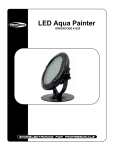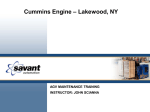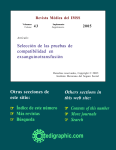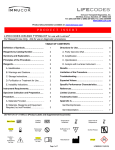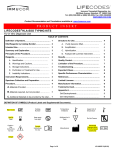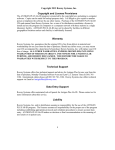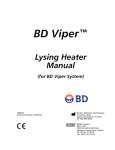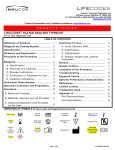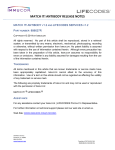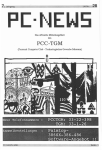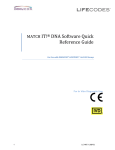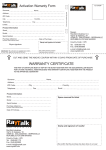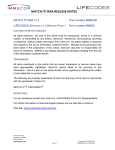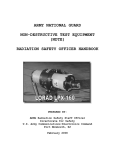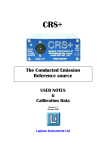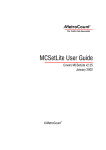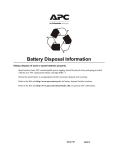Download PRODUCT INSERT - Immucor, Inc.
Transcript
Gen-Probe Transplant Diagnostics, Inc. 550 West Avenue, Stamford, CT 06902 Tel: (203) 328-9500 or (888) 329-0255, Fax: (203) 328-9599 WWW.GEN-PROBE.COM PRODUCT INSERT LIFECODES RBC-R TYPING KIT for use with Luminex® For Research Use Only, Not for In-Vitro Diagnostic Use TABLE OF CONTENTS SECTION Definition of Symbols Intended Use Reagents by Product Number Materials, Reagents and Equipment Required, but not Provided Reagent Storage and Use Genomic DNA Preparation and Use Warnings and Precautions Procedure A. Genomic DNA Purification B. Amplification C. Hybridization D. Analysis using Luminex Instrument E. Analysis using MATCH IT!-RBC Software Troubleshooting PAGE NO 1 2 2 2 3 3 3 4 4 4 4 5 5 6 DEFINITION OF SYMBOLS (Product Labels and Supplemental Documents) Catalog Number Lot Number Expiration Date Caution – See instructions for use (exp) Temperature limitations Upper limit of temperature Keep away from light Sufficient for N tests Do Not Freeze See instructions for use Manufacturer REF Page 1 of 6 LC1129.4 (11/11) PRODUCT DETAILS LIFECODES RBC-R Typing Kit: The LIFECODES RBC-R assay uses single nucleotide polymorphism (SNP) detection by the Polymerase Chain Reaction – Reverse Sequence Specific Oligonucleotide (PCR-RSSO) method. This multiplex assay has been designed to genotype the antigens of the following rare blood groups: Colton – Coa, Cob Dombrock – Hy, Joa, Doa, Dob Scianna – Sc1, Sc2 Lutheran – Lua, Lub Diego – Dia, Dib, Wra, Wrb Landsteiner-Weiner – LWa, LWb Cartwright – Yta, Ytb Knops – Kna, Knb, McCa+, McCb+, SI1, SI2 Cromer - Cra REAGENTS BY PRODUCT NUMBER RBC-R LIFECODES RBC-R Typing Kit for use with Luminex Reagent MX-RBC-R LIFECODES RBC - R Master Mix BM-RBC-R LIFECODES RBC - R Probe Mix DS Dilution Solution ‡ Product # 728200-50 Storage Product Number Fill volume 728202 580 µL 2 to 8°C 728201 810 µL 2 to 8ºC Protect From Light 628515 19.7 mL 18 to 30ºC 50 Sufficient for 50 samples ‡ Probe Mixes are light sensitive: keep away from light. CAUTION: Do not freeze components and Do not use components past their expiration dates. MATERIALS, REAGENTS, AND EQUIPMENT REQUIRED BUT NOT PROVIDED (as listed or equivalent) Reagents or Chemicals or Kits • R-Phycoerythrin Conjugated Streptavidin (SA-PE), 1mg/mL (Lifecodes, Cat. No. 628511) • Recombinant Taq Polymerase (Lifecodes, Cat. No. 167075) • 70% Isopropanol or 20% household bleach Ancillaries • PCR tubes and caps • Corning: #6542 (VWR #29442-354) - 0.2mL 8 strip tubes and caps OR ABGene/ThermoFast 96 well PCR plates, skirted, cat# AB-1000, Natural, 50 plates/box • Thermal cycler (PCR) 96 well plates (Costar®, Cat. No. 6509) • Microseal™ Film (Bio-Rad, Cat. No. MSA-5001) or Tape (Costar®, Cat. No. 6524) • Barrier filter tips • Pipettors, multichannel pipettors and tips (1-20µL, 20-200µL, 1000µL) • MATCH IT!-RBC Software (Supplied; Lifecodes, Cat. No. 888729) • MATCH IT!-RBC - Lot Information Update CD (Supplied; Lifecodes, Cat. No. 888728) Instruments and Related Ancillaries • Luminex® Instrument and XY Platform (Lifecodes, Cat. No. 888300) • Luminex Sheath Fluid (Lifecodes, Cat. No. 628005) • Luminex Calibration beads o Cal 1 (Lifecodes, Cat. No. 628006) o Cal 2 (Lifecodes, Cat. No. 628007) o Con 1 (Lifecodes, Cat. No. 628008) o Con 2 (Lifecodes, Cat. No. 628009) • Thermal cycler (Required Specifications: heated lid, adjustable ramp times, minimal thermal range 2 to 100ºC, accuracy within ± 0.5ºC) • Vortex mixer • Bath sonicator (Fisher Scientific, Cat. No. FS15 or FS20) • Microcentrifuge • Heat Block (Fisher Scientific Standard Heatblock, Cat. No. 13259-030) • Rubber mat or metal plate Page 2 of 6 LC1129.4 (11/11) REAGENT STORAGE AND USE 1. Refer to kit component packaging label for proper storage temperatures. 2. If salts have precipitated out of solution during shipping or storage, resolubilize completely prior to use by vortexing at room temperature (18 to 30°C). 3. Probe mixes and R-Phycoerythrin Conjugated Streptavidin are light sensitive. Keep away from light. Do not freeze these reagents. 4. Do not use R-Phycoerythrin Conjugated Streptavidin that has been frozen during shipment or storage. 5. Do not use components past their expiration dates. GENOMIC DNA PREPARATION AND USE 1. DNA can be prepared using any preferred method. The assay has been tested on genomic DNA from whole blood. CAUTION: All biological and blood samples should be treated as potentially infectious. Use Universal Precautions when handling. 2. DNA extracted from blood preserved in heparin cannot be used in this assay. 3. The presence of alcohol, detergents or salts may adversely affect DNA amplification. 4. Absorbance measurements of the DNA sample should yield a 260nm to 280nm ratio ranging from 1.65 to 2.0. 5. The isolated DNA should be resuspended and stored in 10mM TRIS, pH 8.0 to 9.0, or in nuclease free water. If a chelating agent such as EDTA is present, the final concentration of the chelating agent should not exceed 0.5mM. 6. Final DNA concentration should be 10 to 200 ng/µL. 7. DNA can be used immediately after isolation or stored at –20ºC for up to 1 year. Repeated freeze/thawing should be avoided since this can result in DNA degradation. WARNING AND PRECAUTIONS 1. 2. 3. 4. For Research Use Only – Not for in vitro diagnostic use. Separate pipettes should be designated for Pre-PCR manipulations as well as for Post-PCR manipulations. All biological and blood samples should be treated as potentially infectious. Use Universal Precautions when handling. Dilution Solution, Probe mixes, Taq Polymerase and R-Phycoerythrin Conjugated Streptavidin contain hazardous compounds. Avoid contact with skin and eyes and dispose of accordingly. See Material Safety Data Sheets for additional information (www.gen-probe.com). Page 3 of 6 LC1129.4 (11/11) PROCEDURE A. Genomic DNA Purification: 1. See Genomic DNA Preparation and Use for important information. 2. Purify DNA using method of choice. 3. Final concentration of genomic DNA should be 10 to 200 ng/ul. 4. Adjust DNA concentrations, if necessary, using nuclease free water. Keep all samples at similar concentrations. B. Amplification: 1. Bring Master Mix kit component to room temperature. 2. Prepare Master Mix reaction solution using the following table. Prepare immediately prior to use. Do not store. Total volume per reaction is 25µL. It is recommended that one water blank be run with each test. Component Amount per PCR sample reaction Master Mix 10 µL Genomic DNA Total of ~100 ng Taq polymerase 0.25 µL (1.25 U) Nuclease-free water To 25 µL final volume 3. Aliquot DNA (~100ng optimal; 40 to 200ng acceptable) into PCR tubes. 4. Aliquot Master Mix reaction solution into tubes. Discard any remaining Master Mix reaction solution. 5. Place samples in the thermal cycler and run amplification program. The program shown below has yielded optimal results in internal testing. Conditions may need to be altered in order to optimize thermal profiles for individual thermal cyclers used. 95º C for 4 min Number of cycles: 1 95º C for 30 sec 51º C for 45 sec 65º C for 2 min : 30 sec Number of cycles: 45 65º C for 5 min C. Hybridization: IMPORTANT NOTES: Pre-warm Probe Mix. Keep beads protected from light. Vortex beads. Dilute all hybridized samples at 56C before removing tray. 1. 2. 3. 4. 5. 6. Warm Probe Mix at 55º to 60ºC for 5 to 10 minutes. Sonicate and vortex Probe Mix briefly to thoroughly resuspend the beads. Aliquot 15µL of Probe Mix into each well of a Costar plate (vortex Probe Mix after every 8 samples). Aliquot 5µL of PCR product into each well. Seal plate with polyethylene tape or film. Place in thermal cycler and run hybridization program. Use a rubber mat or metal plate to prevent evaporation. 56ºC for 22 min 56ºC HOLD Page 4 of 6 LC1129.4 (11/11) 7. Prepare a mixture of Dilution Solution and PE-Streptavidin (1mg/ml) using the table shown following. Protect mixture from light. # of Samples 1 5 10 20 50 Dilution Solution (DS) 170 µL 850 µL 1700 µL 3400 µL 8500 µL SA-PE 3.4 µL 17.0 µL 34.0 µL 68.0 µL 170.0 µL 8. At the 56C HOLD step, dilute each sample with 170L of the Dilution Solution/PE-Streptavidin mixture. NOTE: Do not remove the tray from the thermal cycler until all samples have been diluted. 9. Remove the sample tray from the thermal cycler and immediately place in the Luminex instrument for analysis. NOTE: For best results, acquisition should begin within 5 minutes after hybridization program ends. D. Analysis Using Luminex Instrument (refer to Luminex IS User’s Manual for instrument operation, including daily startup, calibration, maintenance, and shutdown procedures): 1. Turn on the Luminex Instrument between 30 minutes and 4 hours before assaying the samples. 2. Import the lot specific IDT template provided on the “RBC Lot Information Update CD” using the Luminex IS User’s Manual. Please note that the template versions are lot number specific and correspond to the kit lot numbers. 3. Prior to analyzing the samples on the Luminex Instrument, set up a Batch Run by which the samples will be analyzed. For example, if analyzing an RBC run, add a Batch Run for RBC. a. Select Create a New Batch from the File menu. b. Follow the stepwise instructions that appear on the screen for creating batches. c. When naming the batch, do not include commas in the name; information located after a comma will be lost in data export. d. For further instructions on creating batches and multibatches, refer to the Luminex IS User’s Manual. 4. Click the Eject icon to eject the plate holder. Place the 96 well thermal cycler plate containing the samples in the XYP heater block present on the plate holder. 5. Click the Retract icon. The samples are now ready to be analyzed. An instrument priming step should be performed before starting the run. 6. After the samples have been run through the instrument, a sanitization step with 70% Isopropanol or 20% household bleach should be performed followed by two wash steps. The instrument can be turned off at this point if it is not going to be used for the remainder of the day. 7. After a batch is complete, the data are exported as a Comma Separated Values (csv) file. These files are named ‘OUTPUT.CSV’ and saved in a folder with the Batch Name entered into the Luminex IS. These data are then available for analysis using the MATCH IT!-RBC software. E. Analysis Using Lifecodes MATCH IT!-RBC Software: 1. Import the lot specific EDS file provided on the “RBC Lot Information Update CD" using the Lot Data Set Import tab. 2. Import the csv file obtained from Luminex analysis using the Batch Data Import tab. 3. Analyze the batch using the User’s Manual for MATCH IT!-RBC Software. 4. See User’s Manual for MATCH IT!-RBC Software User’s Manual for a description of possible run results. a. Indeterminate results are noted by an "ID" label in the software report. b. Indeterminate (ID) results can occur due to low amplification, probe value too close to the cut off, or an unexpected rare result. In these cases, the sample should be repeated or typed using another red cell typing technology. Page 5 of 6 LC1129.4 (11/11) TROUBLESHOOTING PROBLEM Low Bead Count POSSIBLE CAUSE Probe Mix not well suspended Instrument not functioning properly Out of Calibration Sample flow path blocked “Failed” sample Sample failed to amplify or amplified poorly Low DNA SOLUTION Prewarm, sonicate, and vortex probe mix and repeat assay. Calibrate instrument (refer to Luminex IS User’s Manual). Remove and sonicate needle. Perform backflush. Call Lifecodes Technical Support if problem persists (888-329-0255). Check DNA concentration and purity (see Genomic DNA Preparation and Use). Salts in Master Mix are out of solution Heat Master Mix at 37ºC for 5 minutes, vortex gently, and spin down briefly (2 to 5 secs). Poor Taq Polymerase Use only Recombinant Taq. Lifecodes Cat. No. 167075 is recommended. Run thermal profile on thermal cycler to verify parameters are within specified parameters. Adjust if necessary. Ensure Dilution Solution is stored at room temperature (18 to 30 ºC). Warm Dilution Solution at 45ºC for 5 minutes before use and vortex. Replace R-Phycoerythrin Conjugated Streptavidin. Amplification conditions not within specific parameters Low Median Fluorescent Intensity (MFI) value Evaporation during hybridization Ensure the plate is sealed tightly. If not using an entire plate, leave one row empty on each side of samples to be assayed to assist in obtaining a tight plate seal. SPECIFIC PERFOMANCE CHARACTERISTICS Specific performance characteristics have not been determined. MANUFACTURER Manufacturer: Gen-Probe Transplant Diagnostics, Inc., 550 West Avenue, Stamford, CT 06902. Phone: 203-328-9500, 888-329-0255 Fax: 203-328-9599 European Technical Service: Phone: +32/3 385 4791 Page 6 of 6 LC1129.4 (11/11)






